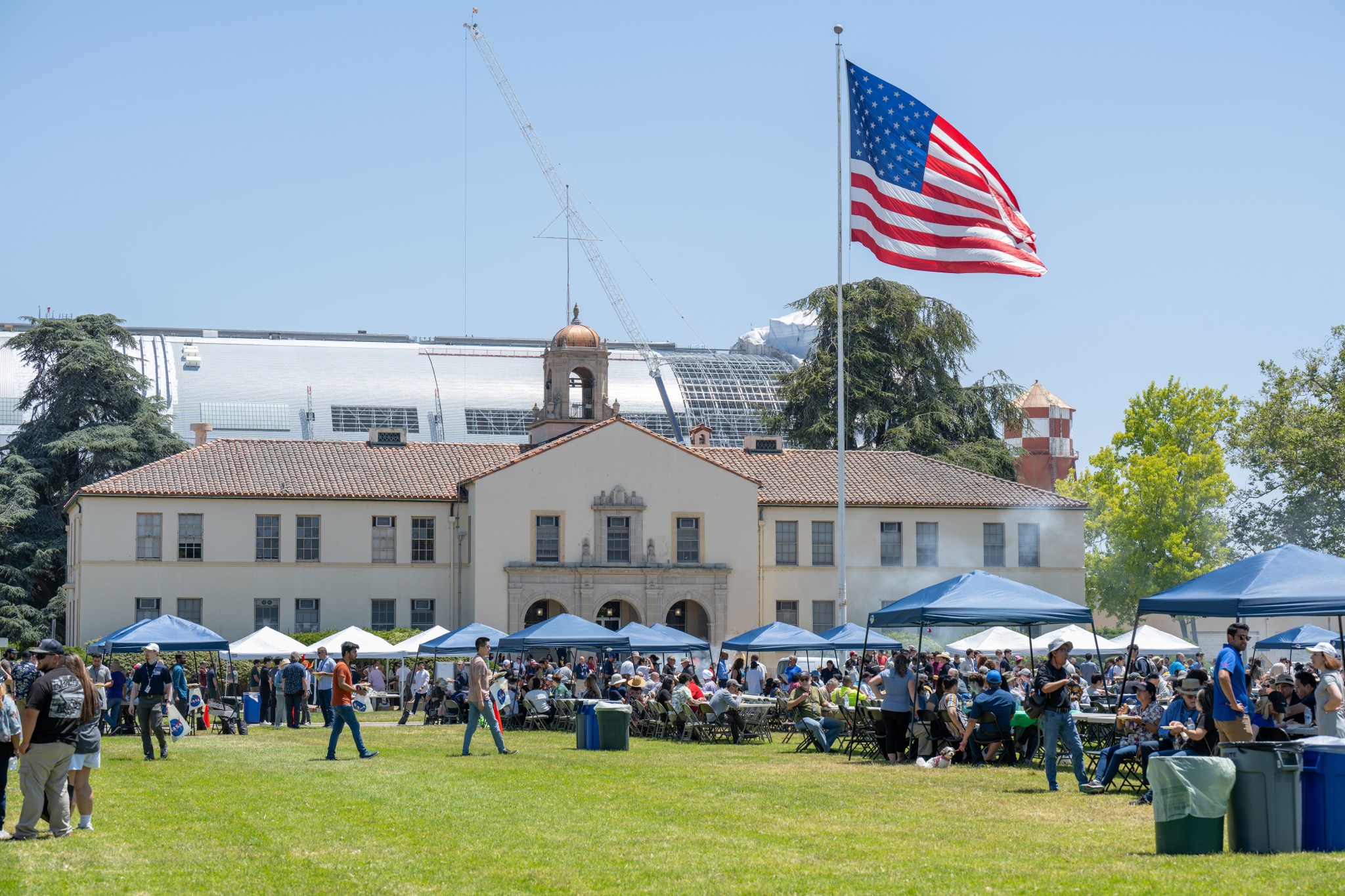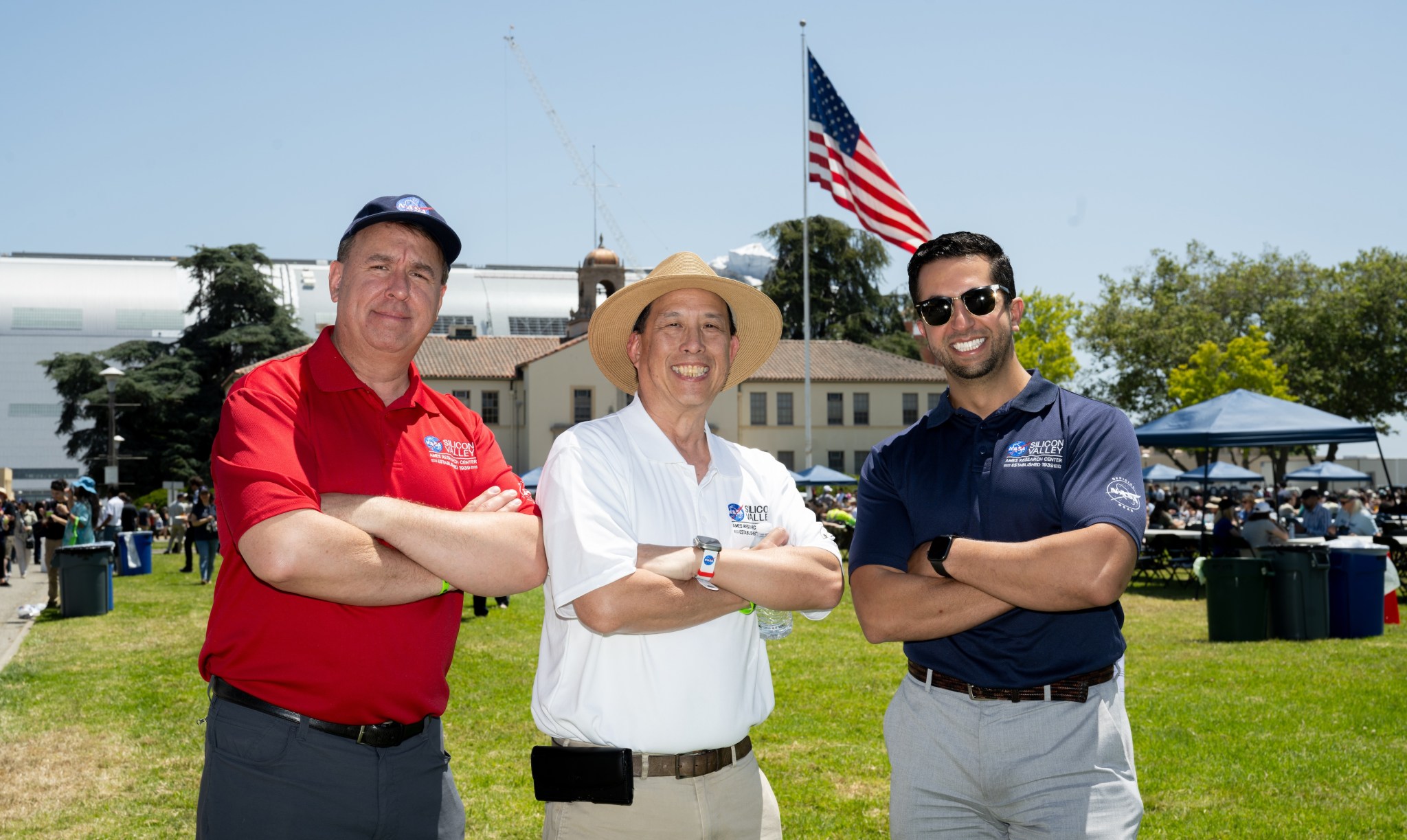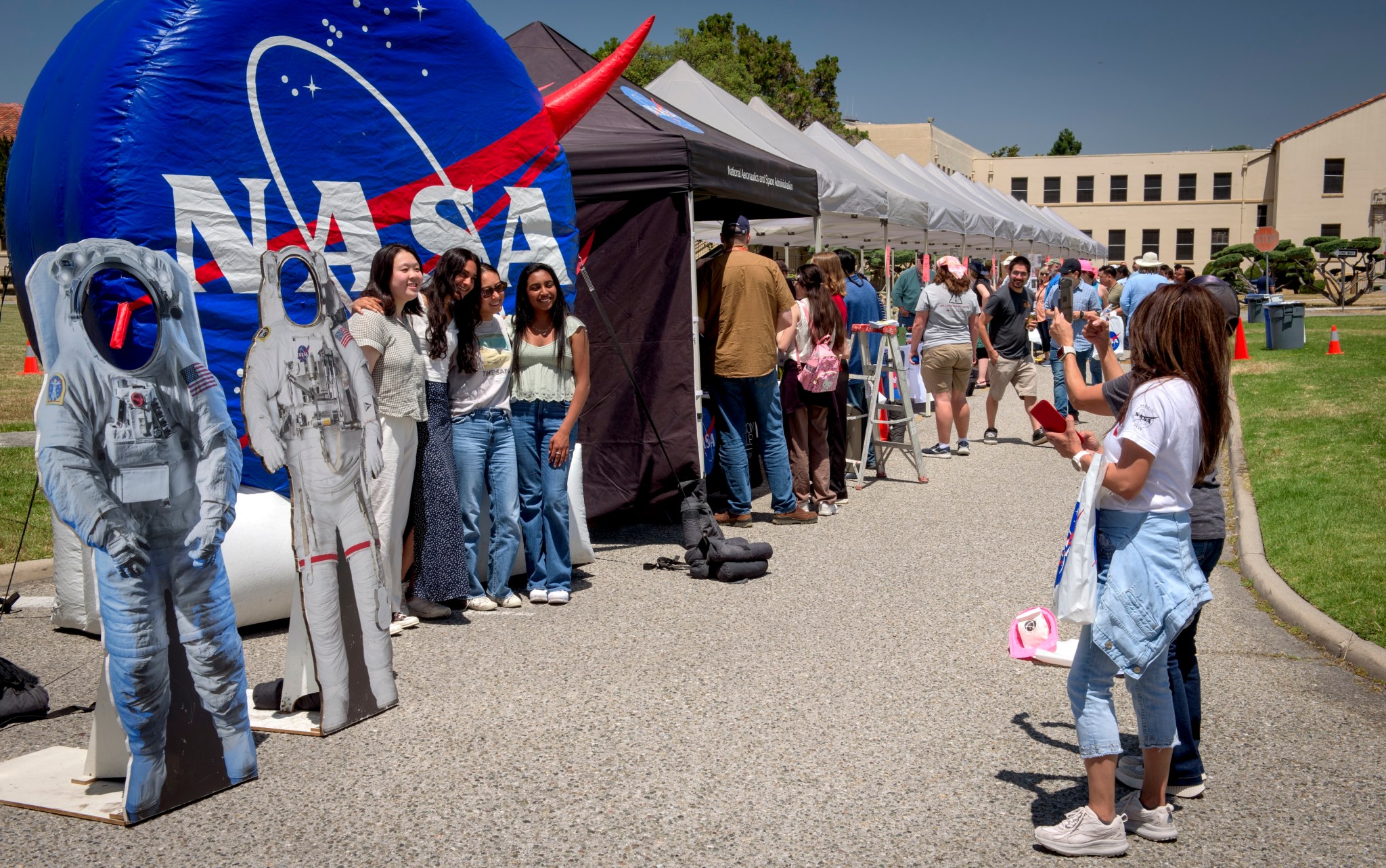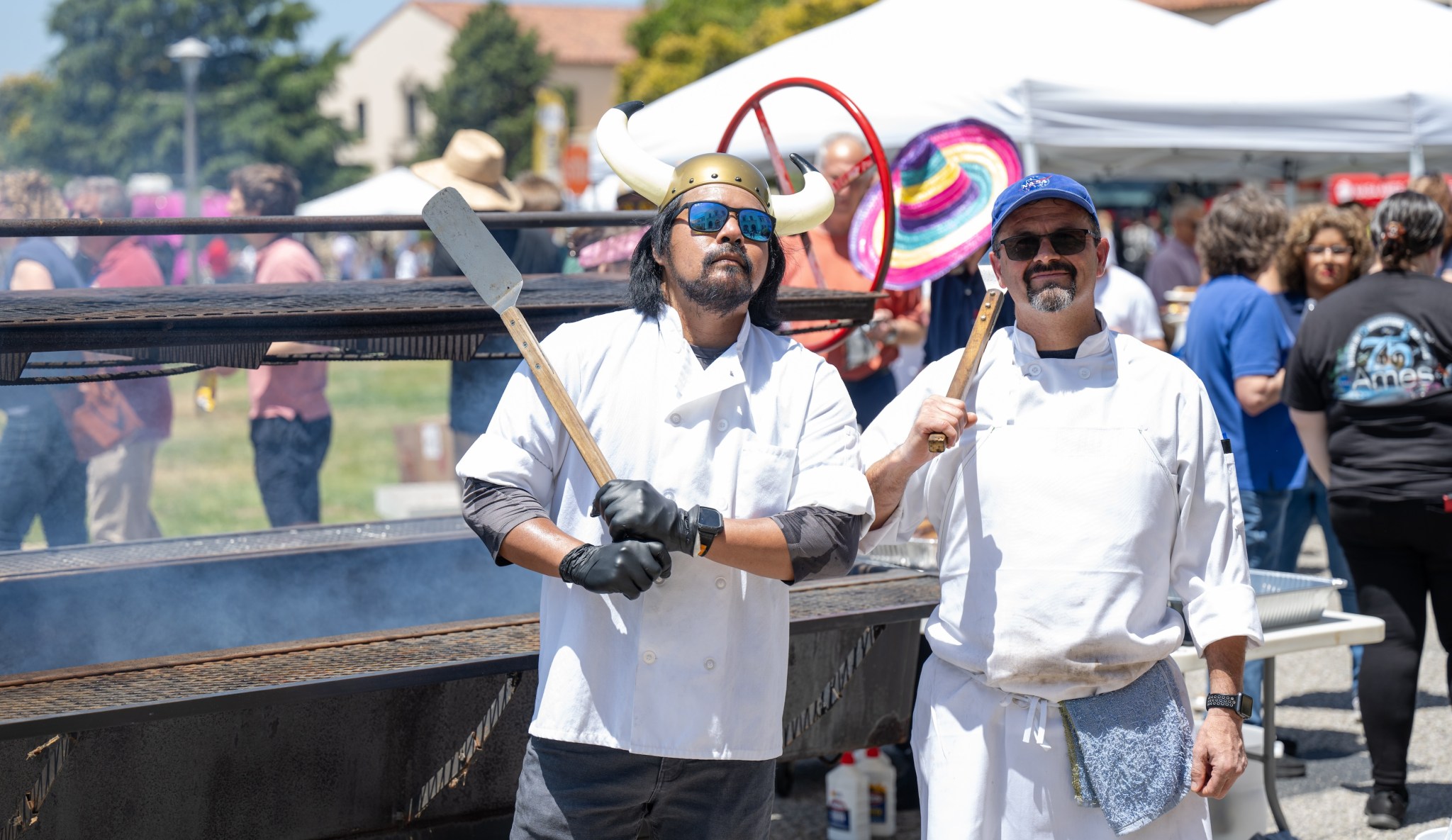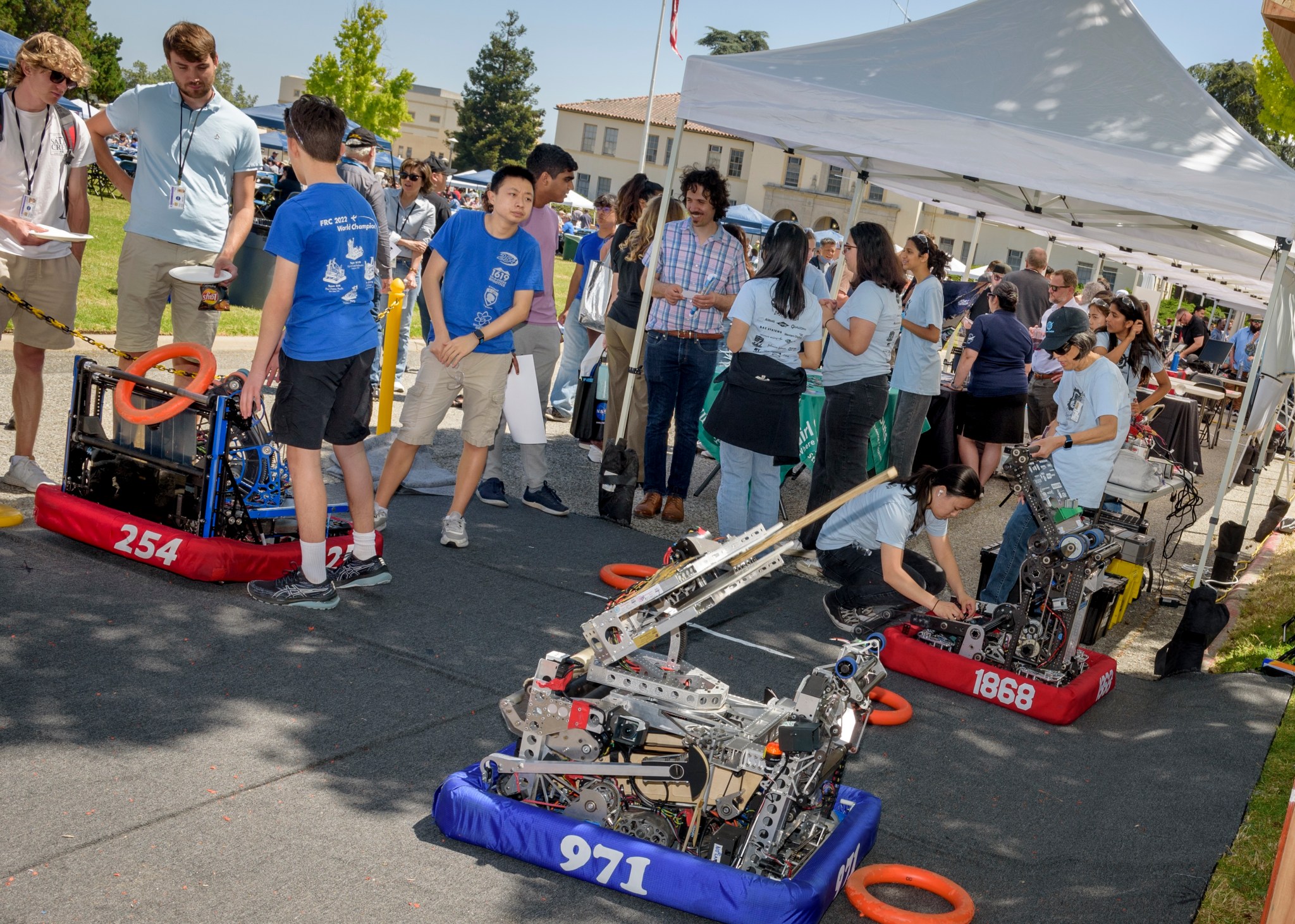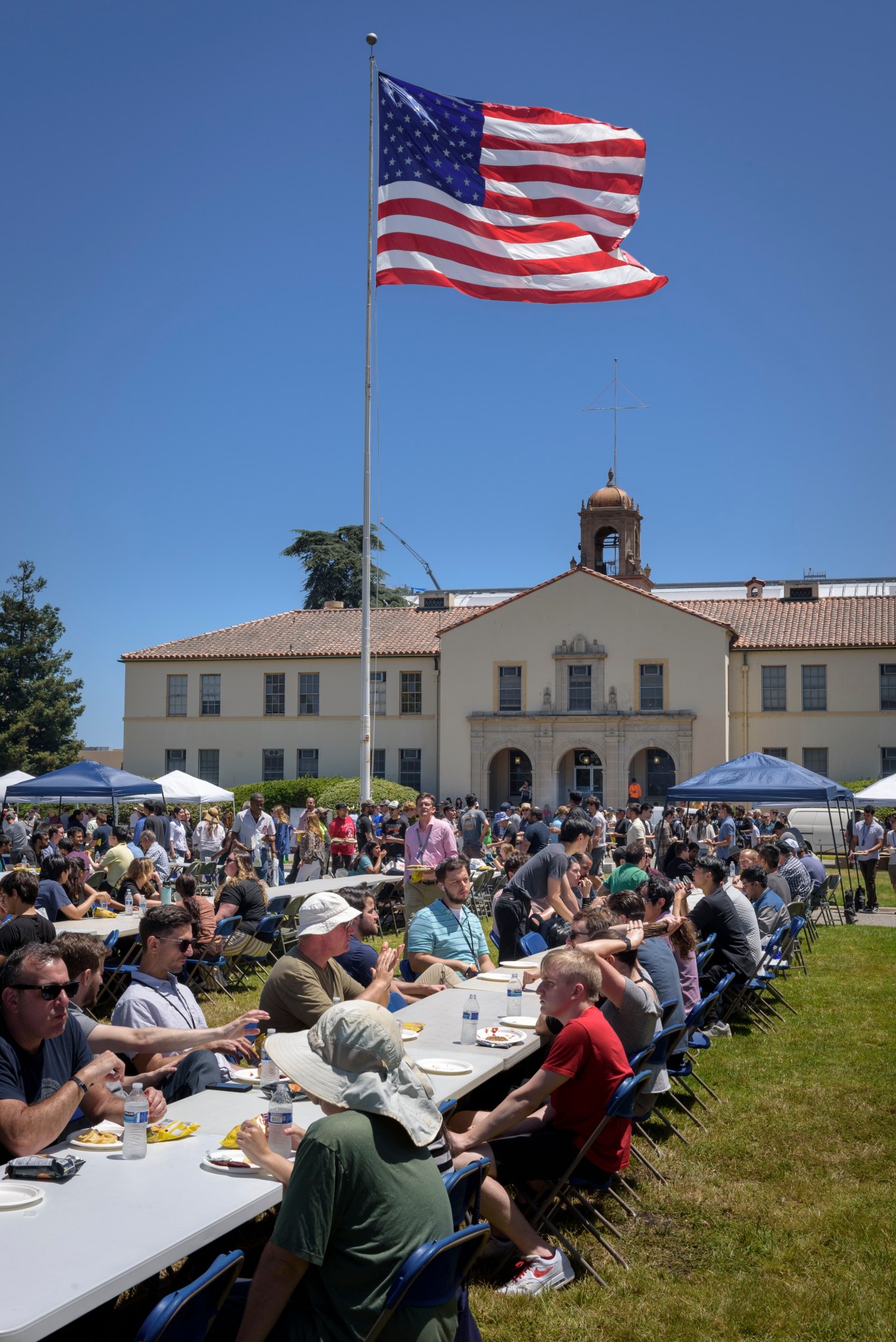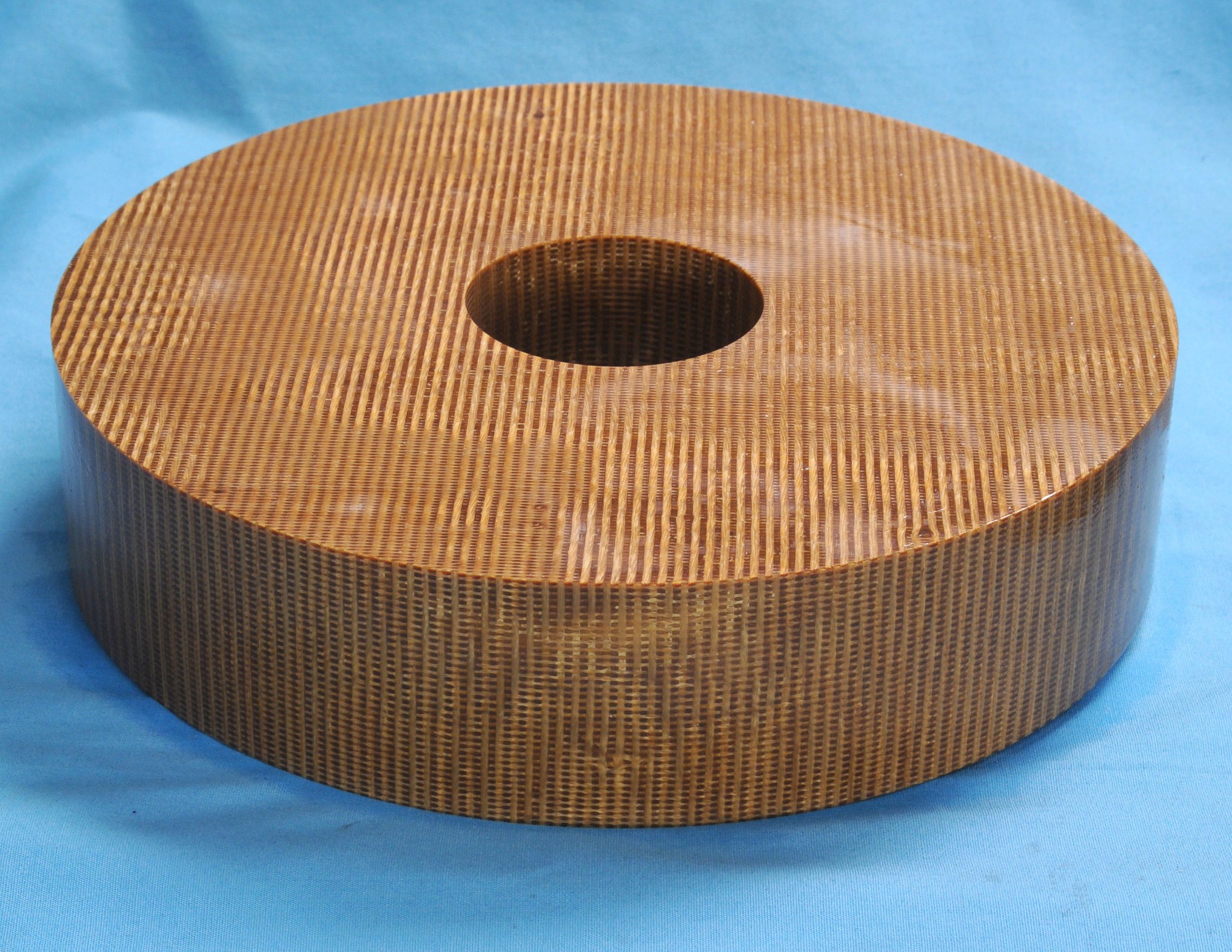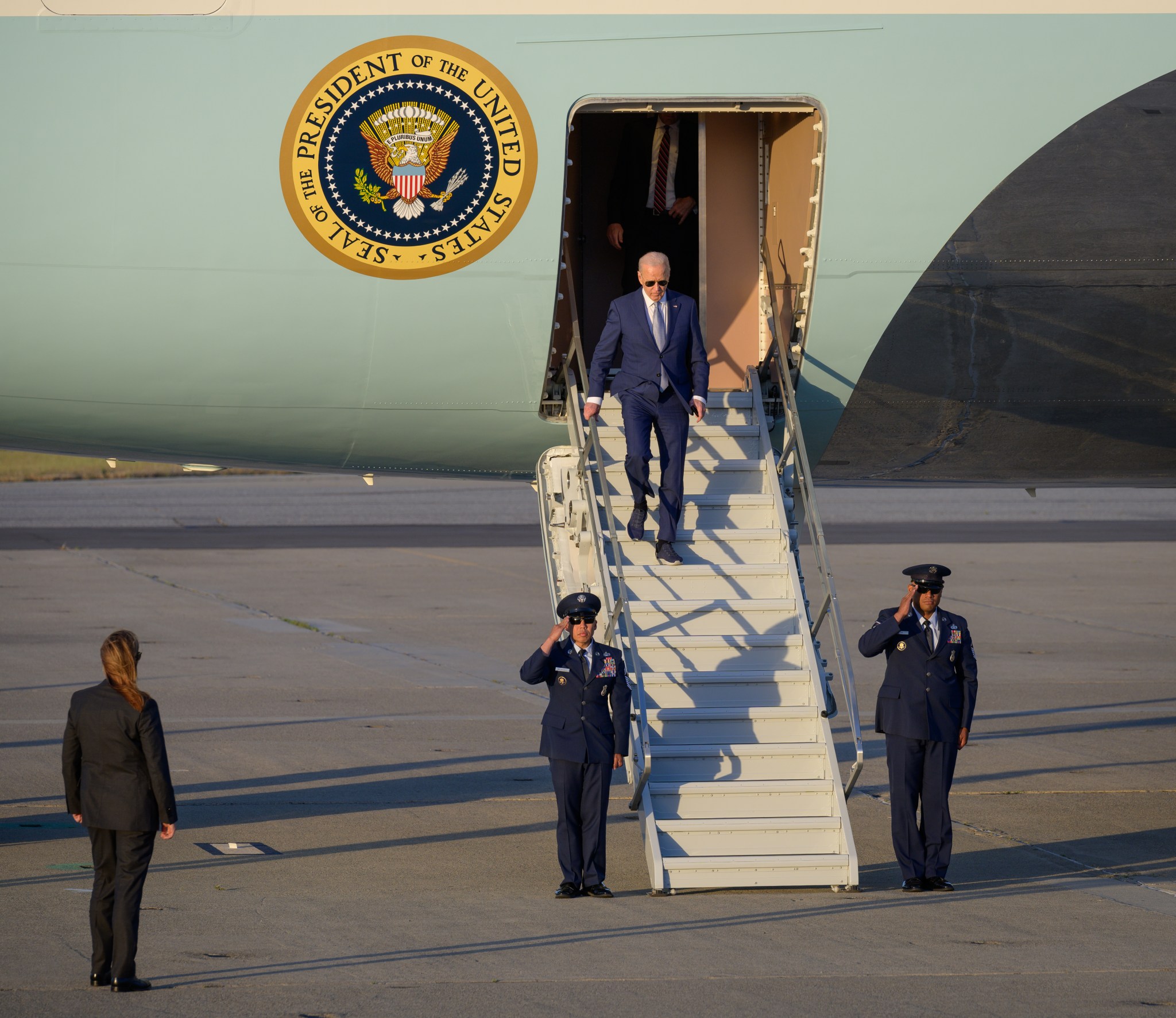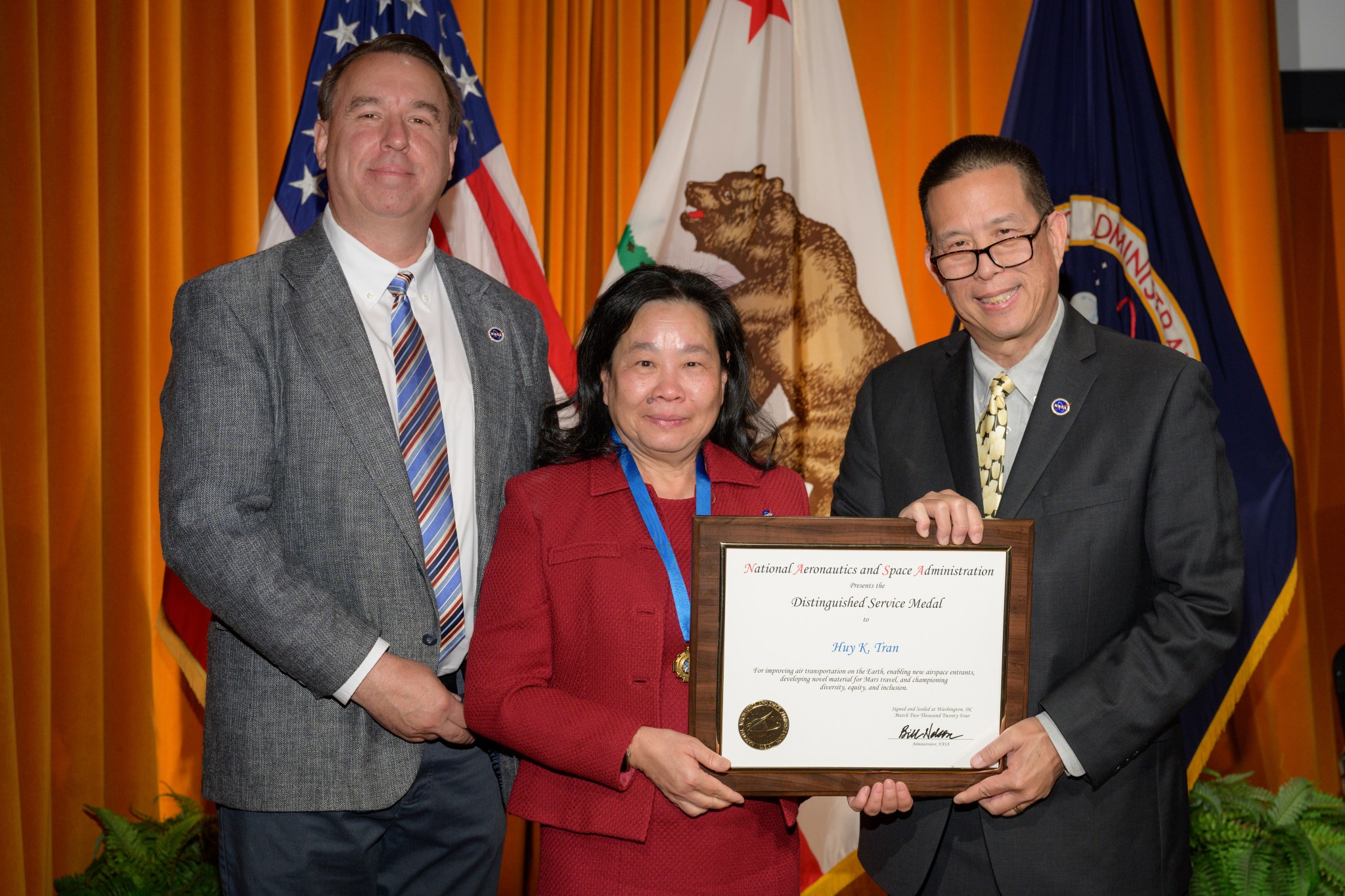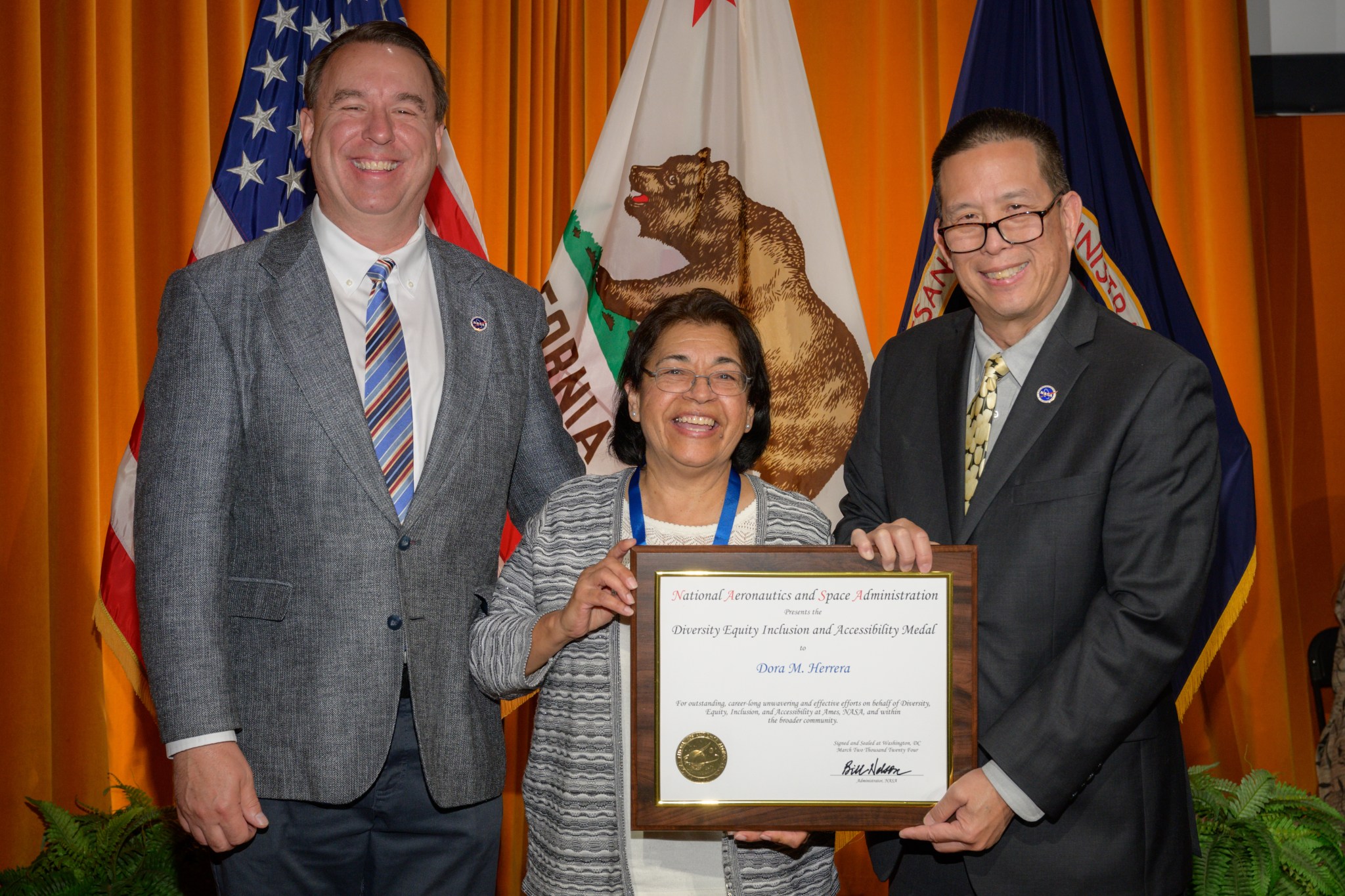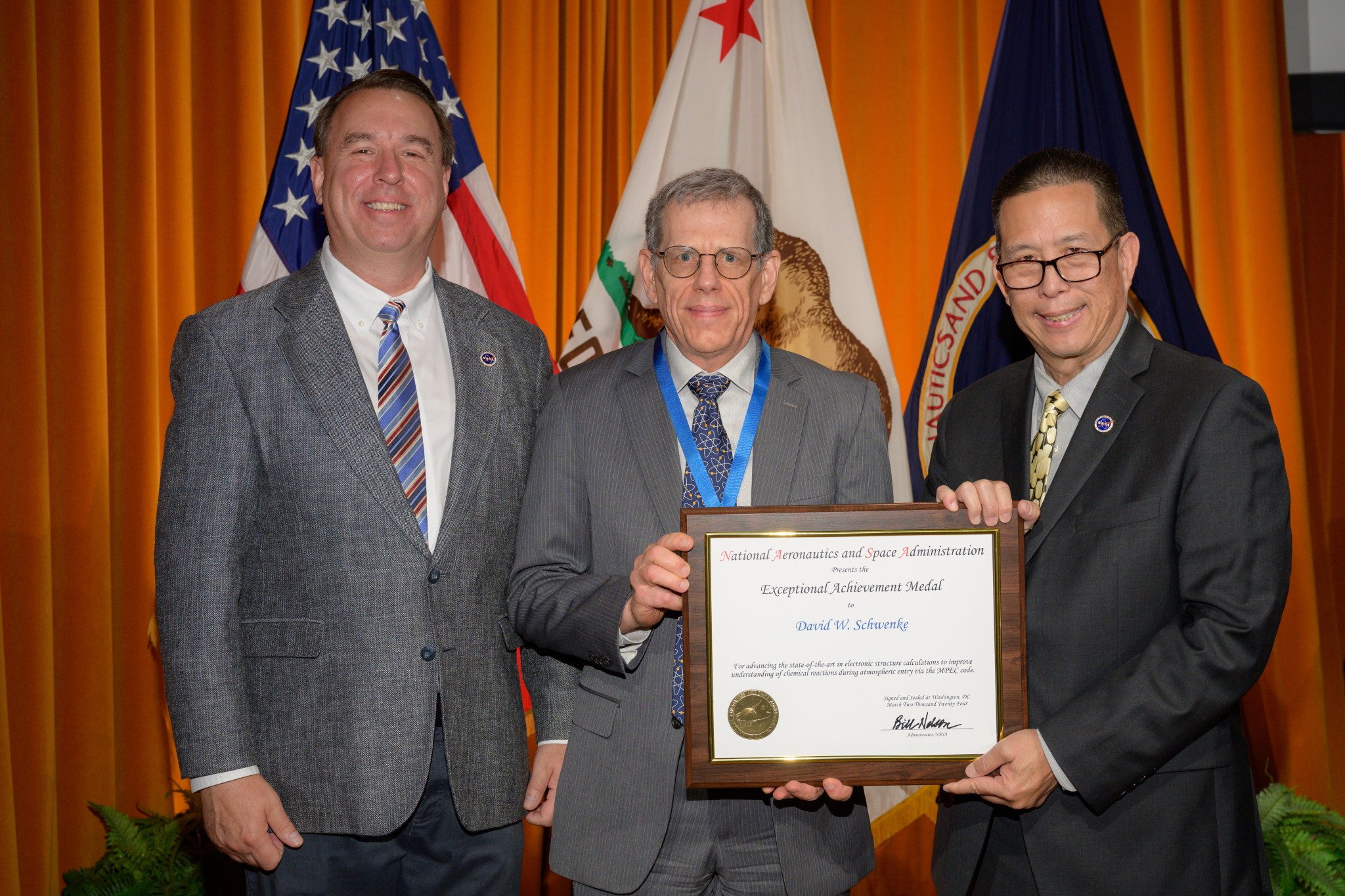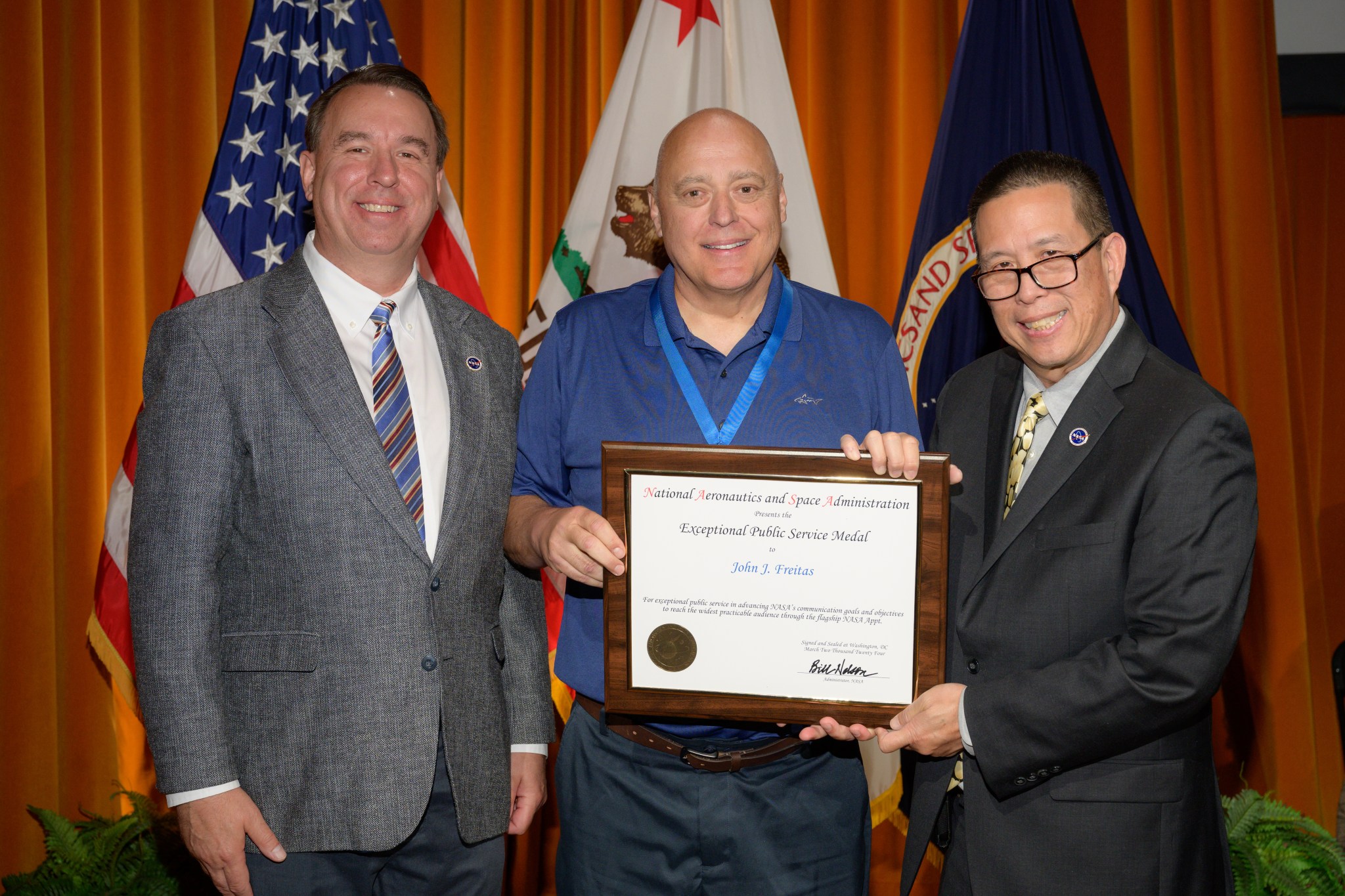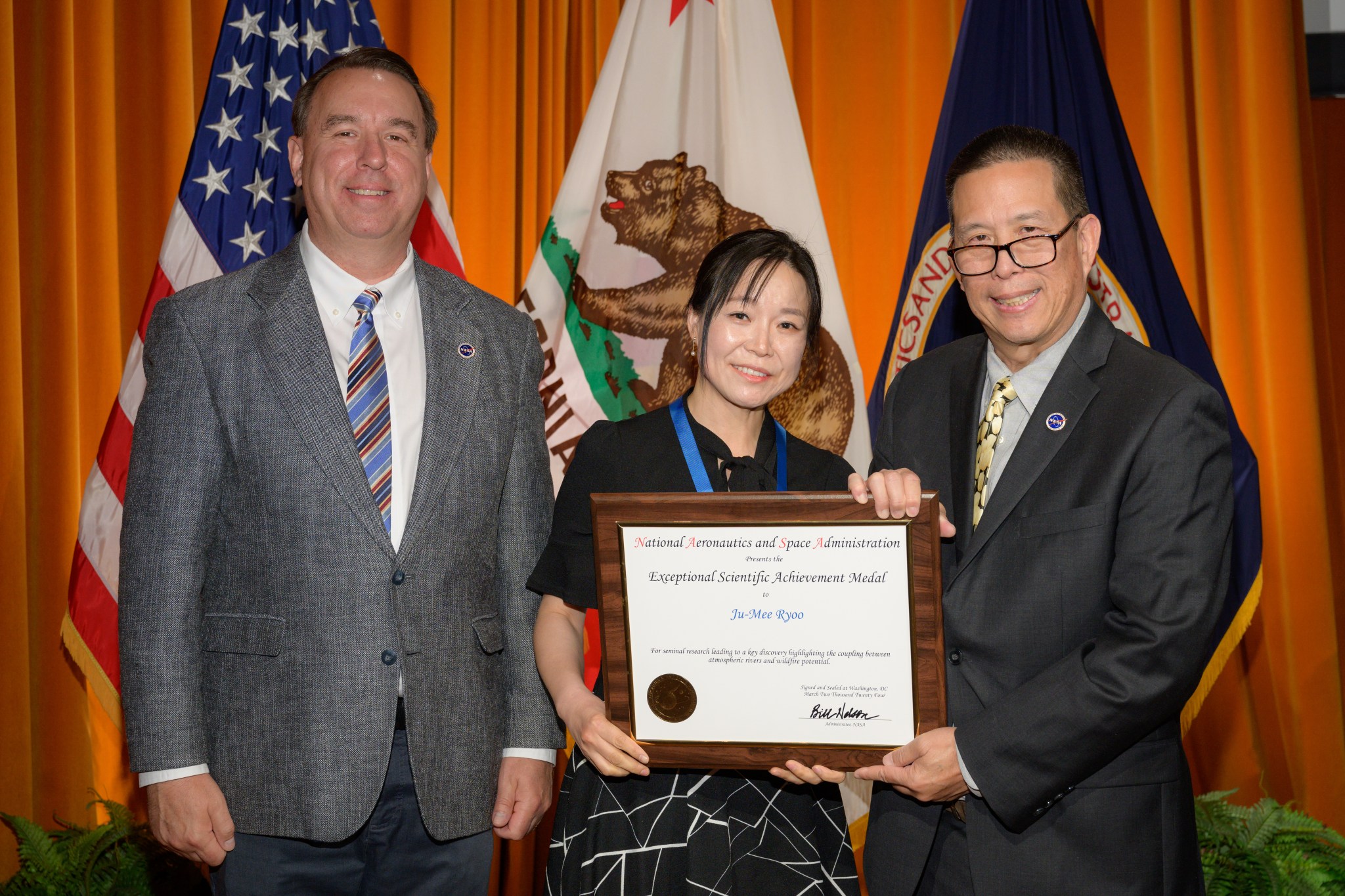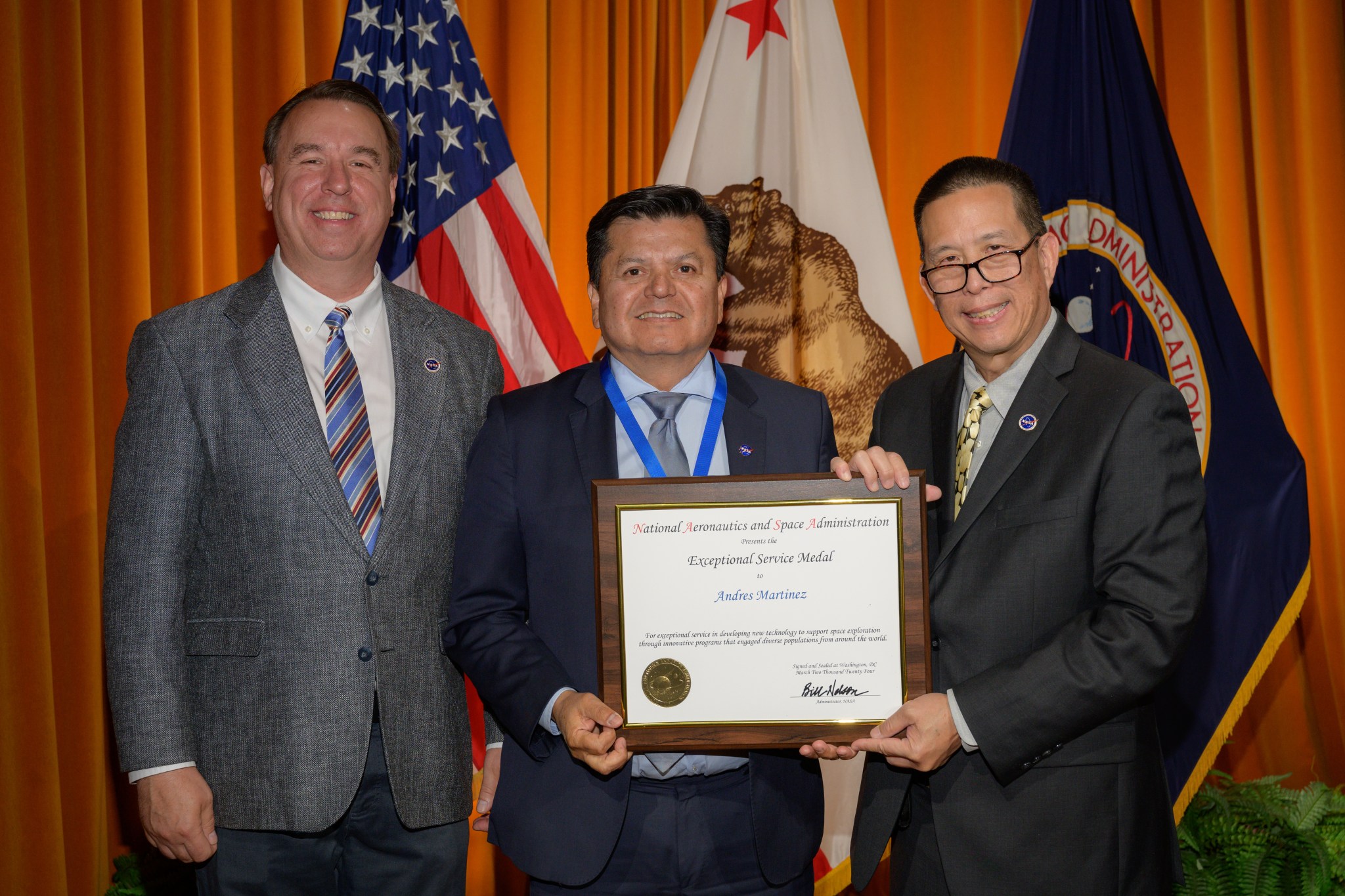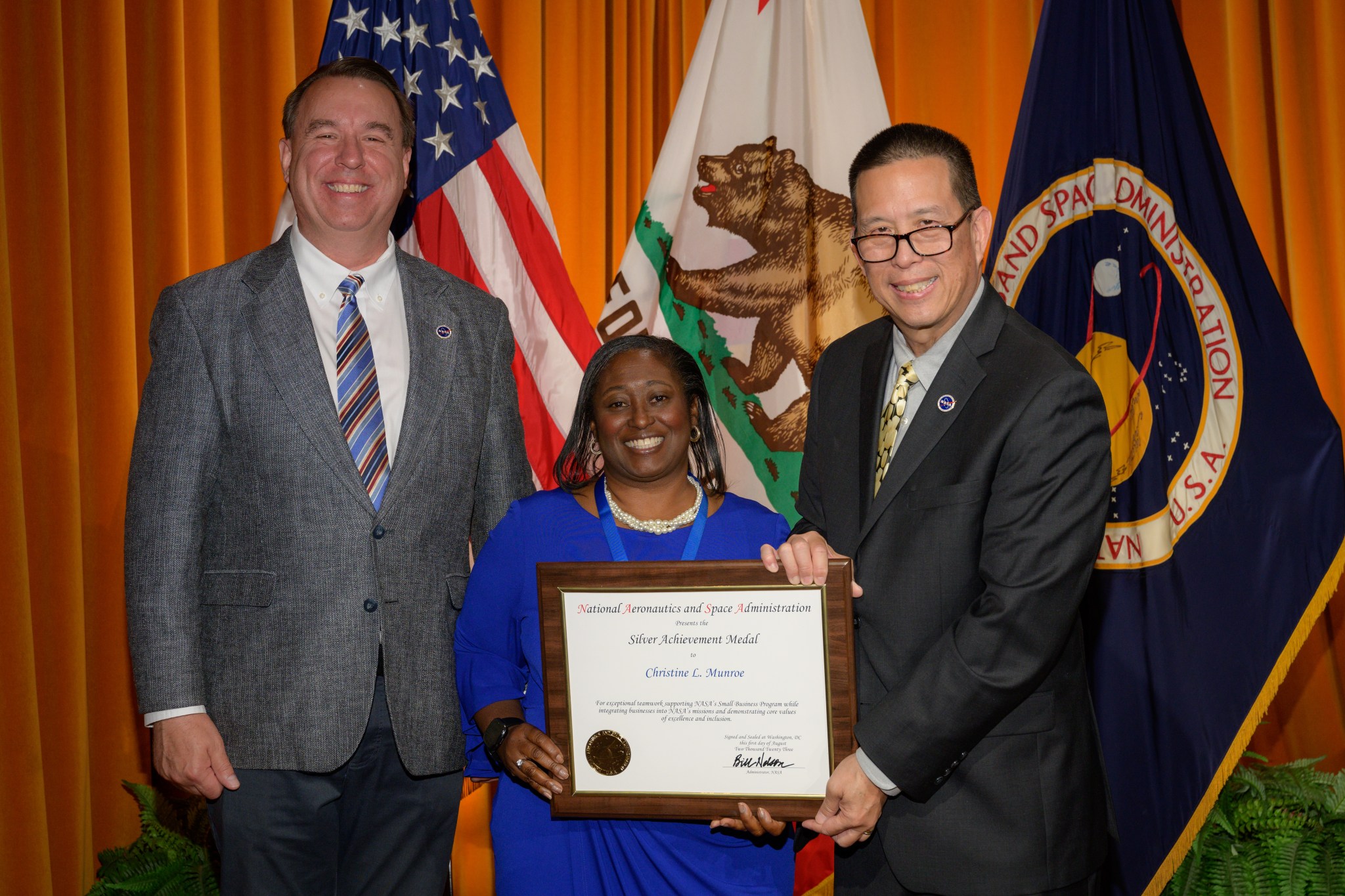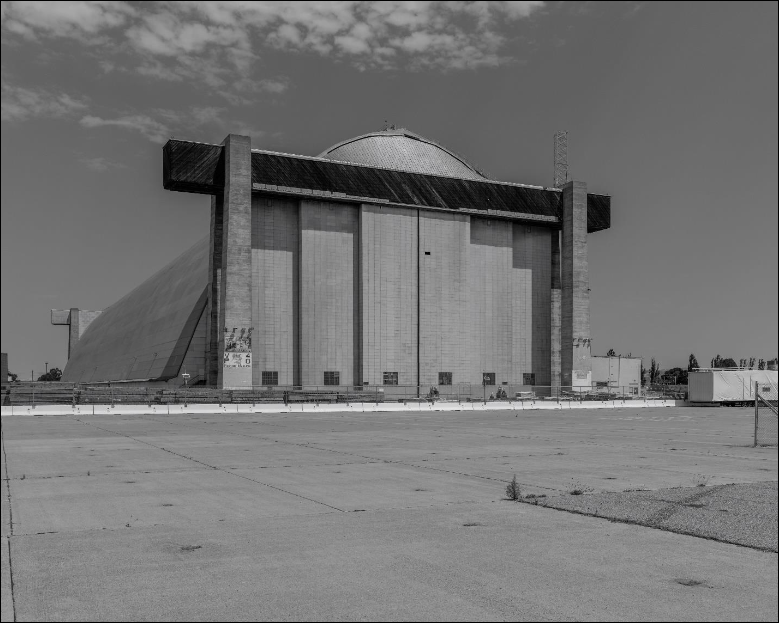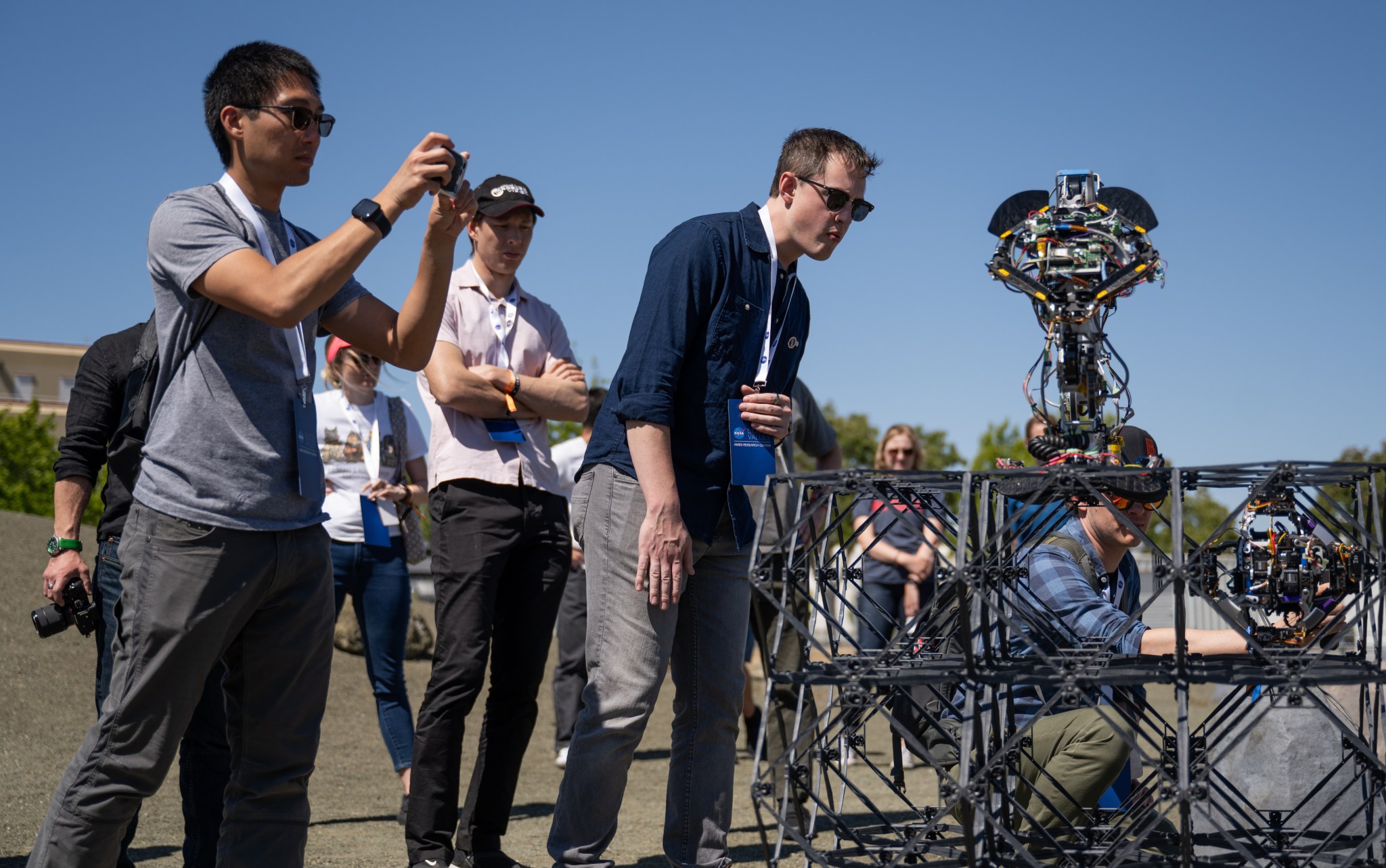Reimagined Ames Visitor Center Opens at Chabot Space & Science Center
A complete transformation is now underway at the NASA Ames Visitor Center at Chabot Space & Science Center in Oakland, California. Significant changes will create a fully reimagined 360-degree experience, featuring new exhibits, models, and more. This transformation opened to the public on June 22, and employees were invited to see the NASA Ames Visitor Center in person.
The first version of the NASA Ames Visitor Center opened in November of 2021. The center director’s office, the office of communications, partnerships, chief counsel, and the many technical organizations provided and contributed artifacts for the opening exhibit alongside our partners at Chabot. Now these objects and stories have been reimagined in a whole new curated experience.
NASA civil servants are able to visit the NASA Ames Visitor Center free of charge with a current NASA identification (PIV badge). One ticket will be issued per PIV badge and can be picked up in person via the visitor service desk at Chabot.
For more information, visit the NASA Ames Visitor Center website, and check out their events calendar to see all of their activities.
DC-8 Flying Laboratory Makes Farewell Flight Over Ames Prior to Retirement
After nearly 40 years of service to science, on May 15 the Ames community had a chance to bid a final farewell to the DC-8 Flying Laboratory as it made its way to retirement in Idaho. NASA Ames, in coordination with NASA Armstrong, had arranged for a low-pass flyover of Ames Research Center at approximately 11:10 a.m. PDT in honor of the staff, scientists, and engineers who enabled the DC-8 to make such a profound impact on Earth science around the globe.
The History of Ames and the DC-8
The NASA DC-8 is a world-class flying laboratory that has played a crucial role in answering fundamental questions across nearly every scientific discipline exploring Earth’s interacting systems, and how they are changing. The versatile research aircraft was unprecedented for its ability to carry multiple instruments and thereby take simultaneous active, passive, and in-situ measurements, while also providing room for 42 investigators onboard and boasting an impressive range of more than 5,000 miles.
Ames has been involved in the science operations of the DC-8 since its arrival at Moffett Field in 1987, including long after the aircraft moved to NASA Armstrong (then NASA Dryden) in the late 1990s. Scientists at Ames continued to lead air quality and climate investigations. The Earth Science Project Office (ESPO) managed complex DC-8 deployments all over the world. And the National Suborbital Research Center (NSRC) provided critical engineering for instrument integration and the upgrading of onboard IT systems and networks, providing global satellite communications to enable real-time science anywhere in the world.
During its first scientific mission, the DC-8 helped to establish the primary cause of the ozone hole over the southern Pacific. Other early missions focused on atmospheric science and developing new instruments for remote sensing. This work ultimately led to the upcoming NASA-ISRO Synthetic Aperture Radar (NISAR) mission, launching later this year, which will provide new insights into Earth’s processes.
The DC-8 went on to provide calibration and validation for numerous satellite missions, including the Total Ozone Mapping Spectrometer (TOMS) series of missions and later for the Aura satellite. The DC-8 also provided critical measurements over both poles as part of Operation IceBridge.
The DC-8 successfully completed its final mission in March of this year, flying atmospheric sampling instruments for the Airborne and Satellite Investigation of Asian Air Quality (ASIA-AQ) campaign. Over the last decade, the DC-8 has also served an important role in training the next generation of Earth scientists and engineers through the Student Airborne Research Program (SARP).
As we bid farewell to this special aircraft, the DC-8 has cleared the runway for the next generation of flying laboratory: the B777. A study performed by the National Academies of Science and Medicine strongly endorsed the need for a NASA flying laboratory to replace the DC-8, resulting in the acquisition of the B777. The team at Ames is working together with NASA Langley and NASA HQ to ensure the B777 will continue to support the science community and exceed the capabilities of the DC-8 with longer range, endurance, and payload capacity: honoring and expanding its legacy for generations of scientists to come.
Congratulations to Dr. Lynn Rothschild and Team for the NASA Innovative Advanced Concepts Phase III
The agency has awarded Dr. Lynn Rothschild, a senior research scientist here at Ames, and her team within our Science Directorate, a $2 million Phase III grant under the NASA Innovative Advanced Concepts (NIAC) program. The award will advance Dr. Rothschild’s visionary research on mycotecture, also known as myco-architecture.
The agency’s ambitious goals to explore the Moon and prepare for human missions to Mars will require the ability to travel with lightweight material which can be used to establish sustainable habitats. Dr. Rothschild and her team are developing technologies to grow self-replicating, self-repairing homes using fungi and mycelia, the unseen underground threads that make up the main part of the fungus.
NIAC Phase III aims to further NIAC concepts with the highest potential impact for NASA, other government agencies, or commercial partners. The agency awarded the last Phase III grant in 2021. The grant will enable the team to progress towards testing in low Earth orbit.
Dr. Rothschild’s research is just one example of how Ames is advancing the groundbreaking research fundamental to future missions to the Moon, Mars, and beyond.
Congratulations to Dr. Rothschild for this tremendous achievement!
Swarming for Success: Starling Completes Primary Mission
by Tara Friesen
After ten months in orbit, the Starling spacecraft swarm successfully demonstrated its primary mission’s key objectives, representing significant achievements in the capability of swarm configurations.
Swarms of satellites may one day be used in deep space exploration. An autonomous network of spacecraft could self-navigate, manage scientific experiments, and execute maneuvers to respond to environmental changes without the burden of significant communications delays between the swarm and Earth.
“The success of Starling’s initial mission represents a landmark achievement in the development of autonomous networks of small spacecraft,” said Roger Hunter, program manager for NASA’s Small Spacecraft Technology program at NASA’s Ames Research Center in California’s Silicon Valley. “The team has been very successful in achieving our objectives and adapting in the face of challenges.”
Sharing the Work
The Distributed Spacecraft Autonomy (DSA) experiment, flown onboard Starling, demonstrated the spacecraft swarm’s ability to optimize data collection across the swarm. The CubeSats analyzed Earth’s ionosphere by identifying interesting phenomena and reaching a consensus between each satellite on an approach for analysis.
By sharing observational work across a swarm, each spacecraft can “share the load” and observe different data or work together to provide deeper analysis, reducing human workload, and keeping the spacecraft working without the need for new commands sent from the ground.
The experiment’s success means Starling is the first swarm to autonomously distribute information and operations data between spacecraft to generate plans to work more efficiently, and the first demonstration of a fully distributed onboard reasoning system capable of reacting quickly to changes in scientific observations.
Communicating Across the Swarm
A swarm of spacecraft needs a network to communicate between each other. The Mobile Ad-hoc Network (MANET) experiment automatically established a network in space, allowing the swarm to relay commands and transfer data between one another and the ground, as well as share information about other experiments cooperatively.
The team successfully completed all the MANET experiment objectives, including demonstrating routing commands and data to one of the spacecraft having trouble with space to ground communications, a valuable benefit of a cooperative spacecraft swarm.
“The success of MANET demonstrates the robustness of a swarm,” said Howard Cannon, Starling project manager at NASA Ames. “For example, when the radio went down on one swarm spacecraft, we ‘side-loaded’ the spacecraft from another direction, sending commands, software updates, and other vital information to the spacecraft from another swarm member.”
Autonomous Swarm Navigation
Navigating and operating in relation to one another and the planet is an important part of forming a swarm of spacecraft. Starling Formation-Flying Optical Experiment, or StarFOX, uses star trackers to recognize a fellow swarm member, other satellite, or space debris from the background field of stars, then estimate each spacecraft’s position and velocity.
The experiment is the first-ever published demonstration of this type of swarm navigation, including the ability to track multiple members of a swarm simultaneously and the ability to share observations between the spacecraft, improving accuracy when determining each swarm member’s orbit.
Near the end of mission operations, the swarm was maneuvered into a passive safety ellipse, and in this formation, the StarFOX team was able to achieve a groundbreaking milestone, demonstrating the ability to autonomously estimate the swarm’s orbits using only inter-satellite measurements from the spacecraft star trackers.
Managing Swarm Maneuvers
The ability to plan and execute maneuvers with minimal human intervention is an important part of developing larger satellite swarms. Managing the trajectories and maneuvers of hundreds or thousands of spacecraft autonomously saves time and reduces complexity.
The Reconfiguration and Orbit Maintenance Experiments Onboard (ROMEO) system tests onboard maneuver planning and execution by estimating the spacecraft’s orbit and planning a maneuver to a new desired orbit.
The experiment team has successfully demonstrated the system’s ability to determine and plan a change in orbit and is working to refine the system to reduce propellant use and demonstrate executing the maneuvers. The team will continue to adapt and develop the system throughout Starling’s mission extension.
Swarming Together
Now that Starling’s primary mission objectives are complete, the team will embark on a mission extension known as Starling 1.5, testing space traffic coordination in partnership with SpaceX’s Starlink constellation, which also has autonomous maneuvering capabilities. The project will explore how constellations operated by different users can share information through a ground hub to avoid potential collisions.
“Starling’s partnership with SpaceX is the next step in operating large networks of spacecraft and understanding how two autonomously maneuvering systems can safely operate in proximity to each other. As the number of operational spacecraft increases each year, we must learn how to manage orbital traffic,” said Hunter.
NASA’s Small Spacecraft Technology program, based at Ames and within NASA’s Space Technology Mission Directorate (STMD), funds and manages the Starling mission. Blue Canyon Technologies designed and manufactured the spacecraft buses and is providing mission operations support. Rocket Lab USA, Inc. provided launch and integration services. Partners supporting Starling’s payload experiments have included Stanford University’s Space Rendezvous Lab in Stanford, California, York Space Systems (formerly Emergent Space Technologies) of Denver, Colorado, CesiumAstro of Austin, Texas, L3Harris Technologies, Inc., of Melbourne, Florida. Funding support for the DSA experiment was provided by NASA’s Game Changing Development program within STMD. Partners supporting Starling’s mission extension include SpaceX of Hawthorne, California, NASA’s Conjunction Assessment Risk Analysis (CARA) program, and the Department of Commerce. SpaceX manages the Starlink satellite constellation and the Collision Avoidance ground system.
Celebrating Pride at NASA’s Ames Research Center in Silicon Valley
The Intersex Progress Pride flag (beneath the American flag) flies in front of the Administration Building N200 at NASA’s Ames Research Center in California’s Silicon Valley on June 5, to commemorate LGBTQI+ Pride Month. This is the first time the flag has flown at any NASA center. Ames celebrates and honors the LGBTQI+ members of our NASA community and recognizes the continued work to be done to create an inclusive, welcoming, and supportive environment.
Employees enjoy food, entertainment, and science exhibits at Summer Picnic
The Ames summer picnic on June 12 provided employees with musical entertainment, hot dogs and great selfie opportunities with NASA inflatable “meatball” and astronaut cutouts to take selfies with. There also were many booths this year featuring Ames employee resource group displays as well as booths on safety, health, and fitness. Also on display were booths showcasing Ames technical accomplishments such as VIPER, Astrobee, the Mars Helicopter, and much more.
NASA’s Repository Supports Research of Commercial Astronaut Health
by Tara Friesen
NASA’s Open Science Data Repository provides valuable information to researchers studying the impact of space on the human body. Nearly three years after the Inspiration4 commercial crew launch, biological data from the mission represents the first comprehensive, open-access database to include commercial astronaut health information.
Access to astronaut research data from astronauts has historically been limited, due to privacy regulations and concerns, but the field of astronauts is changing as commercial spaceflight becomes feasible for civilians.
“Open-access data is fundamentally transforming our approach to spaceflight research,” said Dr. Sylvain Costes, project manager of the Open Science Data Repository. “The repository is instrumental in this transformation, ensuring that all space-related biological and biomedical data are accessible to everyone. This broad access is vital for driving innovation across fields from astronaut health to terrestrial medical sciences.”
The collaborative efforts in opening data researchers has led to multiple scientific papers on astronaut health published in Nature in June. The papers represents research to better understand the impact of spaceflight on the human body, how viruses might spread in a zero-gravity environment, and how countermeasures may protect humans on future long-duration missions.
Ongoing access to the data captured by commercial astronauts means the research can continue long after the crew returns to Earth, impacting the future of research beyond spaceflight, including cancer and genetic diseases and bone health.
“This series of inspiring articles enabled by the repository and enriched by new data generously shared by commercial astronauts aboard the Inspiration4 mission exemplifies our commitment to open science,” said Costes. “By making our data fully accessible and usable, we’re enabling researchers worldwide to explore new frontiers in space biology.”
NASA’s Open Science Data Repository is based out of the agency’s Ames Research Center in California’s Silicon Valley. NASA continues to pursue the best methods and technologies to support safe, productive human space travel. Through science conducted in laboratories, ground-based analogs, and missions to the International Space Station, NASA continues to research innovative ways to keep astronauts healthy as space explorations continues to the Moon, Mars, and beyond.
3D-MAT – A Thermal Protection Material for the Artemis Generation
by Frank Tavares
The 3-Dimensional Multifunctional Ablative Thermal Protection System (3D-MAT) is a thermal protection material developed as a critical component of Orion, NASA’s newest spacecraft built for human deep space missions. It is able to maintain a high level of strength while enduring extreme temperatures during re-entry into Earth’s atmosphere at the end of Artemis missions to the Moon. 3D-MAT has become an essential piece of technology for NASA’s Artemis campaign that will establish the foundation for long-term scientific exploration at the Moon and prepare for human expeditions to Mars, for the benefit of all.
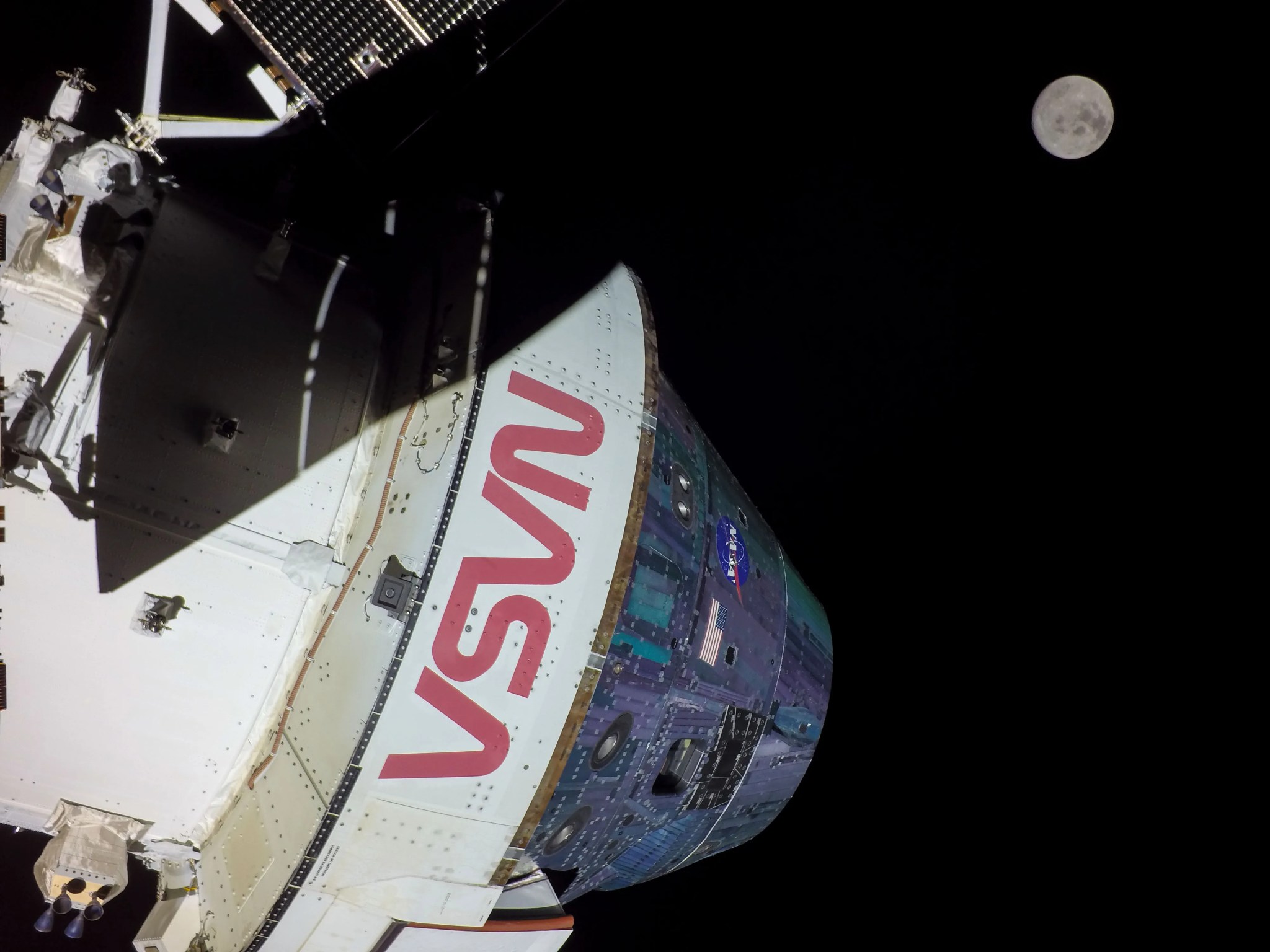
The 3D-MAT project emerged from a technical problem in early designs of the Orion spacecraft. The compression pad—the connective interface between the crew module, where astronauts reside, and the service module carrying power, propulsion, supplies, and more—was exhibiting issues during Orion’s first test flight, Exploration Flight Test-1, in 2014. NASA engineers realized they needed to find a new material for the compression pad that could hold these different components of Orion together while withstanding the extremely high temperatures of atmospheric re-entry. Using a 3D weave for NASA heat shield materials had been explored, but after the need for a new material for the compression pad was discovered, development quickly escalated.
This led to the evolution of 3D-MAT, a material woven with quartz yarn and cyanate ester resin in a unique three-dimensional design. The quartz yarn used is like a more advanced version of the fiberglass insulation you might have in your attic, and the resin is essentially a high-tech glue. These off-the-shelf aerospace materials were chosen for their ability to maintain their strength and keep heat out at extremely high temperatures. 3D-MAT is woven together with a specialized loom, which packs the yarns tightly together, and then injected with resin using a unique pressurized process. The result is a high-performance material that is extremely effective at maintaining strength when it’s hot, while also insulating the heat from the spacecraft it is protecting.
Within three years, 3D-MAT went from an early-stage concept to a well-developed material and has now been integrated onto NASA’s flagship Artemis campaign. The use of 3D-MAT in the Orion spacecraft’s compression pad during the successful Artemis I mission demonstrated the material’s essential role for NASA’s human spaceflight efforts. This development was made possible within such a short span of time because of the team’s collaboration with small businesses including Bally Ribbon Mills, which developed the weaving process, and San Diego Composites, which co-developed the resin infusion procedure with NASA.
The team behind its development won the NASA Invention of the Year Award, a prestigious honor recognizing how essential 3D-MAT was for the successful Artemis flight and how significant it is for NASA’s future Artemis missions. The inventor team recognized includes Jay Feldman and Ethiraj Venkatapathy from NASA’s Ames Research Center in California’s Silicon Valley, Curt Wilkinson of Bally Ribbon Mills, and Ken Mercer of Dynovas.
3D-MAT has applications beyond NASA as well. Material processing capabilities enabled by 3D-MAT have led to other products such as structural parts for Formula One racecars and rocket motor casings. Several potential uses of 3D-MAT in commercial aerospace vehicles and defense are being evaluated based on its properties and performance.
Milestones
- Winner of NASA Invention of the Year Award in 2023
- Flown on Artemis I in 2022
- Being assessed for use by multiple Department of Defense and commercial aerospace entities
Partners
The 3D-MAT project is led out of NASA Ames with the support of various partners, including Bally Ribbon Mills, NASA’s Johnson Space Center in Houston, and NASA’s Langley Research Center in Hampton, Viginia, with the support of the Game Changing Development Program through NASA’s Space Technology Mission Directorate.
U.S. President Joe Biden Arrives Aboard Air Force One
2023 Presidential Rank & NASA Honor Awards Ceremony Held
The annual Presidential Rank & NASA Honor Awards Ceremony was held at Ames, and shown virtually, on May 22 in the Ames Auditorium, in N201. Seventy-three employees were selected for individual Presidential and NASA Honor awards and 27 groups were selected for NASA Group Achievement Awards.
Congratulations to all the recipients. Please see below for the list of awardees.
2023 Presidential Rank and NASA Honor Award Recipients:
Presidential Rank of Meritorious Senior Executive
Michael Hesse
Distinguished Service Medal
Bhavya Lal (A-Suite Nomination)
Thomas R. Norman
Huy K. Tran
Diversity, Equity, Inclusion, and Accessibility Medal
Dora M. Herrera
Parag A. Vaishampayan
Early Career Achievement Medal
Natasha E. Batalha
Mirko E. Blaustein-Jurcan
Athena Chan
Kathryn M. Chapman
Chad J. Cleary
Christine E. Gregg
Supreet Kaur
James R. Koch
Elizabeth L. Lash
Terrence D. Lewis
Garrett G. Sadler
Meghan C. Saephan
Jordan A. Sakakeeny
Lauren M. Sanders
Amanda M. Saravia-Butler
Logan Torres
Lauren E. Wibe
Shannah N. Withrow
Emina Zanacic
Exceptional Achievement Medal
Lauren J. Abbott
Parul Agrawal
Steven D. Beard
Janet E. Beegle
Jose V. Benavides
Divya Bhadoria
Sergio A. Briceno
Holly L. Brosnahan
Karen T. Cate
Fay C. Chinn
William J. Coupe
Frances M. Donovan (Langley Research Center Nomination)
Diana M. Gentry
Lynda L. Haines
Pallavi Hegde
Shu-Chun Y. Lin
Carlos Malpica
Jeffrey W. McCandless
Joshua D. Monk
Mariano M. Perez
Nathan J. Piontak (OPS Nomination)
Vidal Salazar
David W. Schwenke
Eric C. Stern
Exceptional Engineering Achievement Medal
Joseph L. Rios
Mark M. Weislogel
Joseph D. Williams
Exceptional Public Achievement Medal
Danielle K. Lopez
Wade M. Spurlock
Sasha V. Weston
Exceptional Public Service Medal
John J. Freitas (OCOMM Nomination)
Michael J. Hirschberg
Exceptional Scientific Achievement Medal
Noah G. Randolph-Flagg
Ju-Mee Ryoo
Exceptional Service Medal
Soheila Dianati
Robert A. Duffy
Shawn A. Engelland
Thomas P. Greene
Paul W. Lam
Bernadette Luna
Andres Martinez
Ramsey K. Melugin
Owen Nishioka
Kathryn B. Packard
Andrzej Pohorille (Posthumously)
Stevan Spremo
Mark S. Washington
Exceptional Technology Achievement Medal
Ruslan Belikov
Norbert P. Gillem
Emre Sozer
Outstanding Leadership Medal
Michael D. Barnhardt
William N. Chan
Marilyn Vasques
Silver Achievement Medal
Christine L. Munroe (MSEO – OSBP Nomination)
Juan L. Torres-Pérez (Langley Research Center Nomination)
Group Achievement Award
ARCTIC 3 Simulation Team
Artemis I Char Loss Anomaly Investigation Team
CapiSorb Visible System Team
Center Engagement Strategy
Convective Processes Experiment-AW and -CV
Design for Maintainability
DIP Planning and Field Test Team
Executive Wildfire Roundtable and Showcase
Flight IACUC
Long Static Pipe Manufacturing Team
Moon to Mars SE&I Verification Compliance Tool
N225 Arc Flash Mishap Investigation Team
NASA Aeronautics Sample Recovery Helicopter Team
NASA Ames SLS CFD Team
Next Generation Life Sciences Data Archive Team
OSHA VPP Recertification Team
Planetary Aeolian Laboratory ROSES Proposal Team
SOFIA Project Closeout Team
Submesoscale Ocean Dynamics Experiment (S-MODE)
The ACCLIP Team
The DCOTSS Team
The IMPACTS Team
The Meteorological Measurement System (MMS)
UAM eVTOL Vehicle Design and Analysis Team
UAM Side-by-Side 2 Aeroperformance Test Team
Western Diversity Time Series Data Collection Team
Wide Field of View
Astronaut Nicole Mann Throws First Pitch at Giants-Angels Game
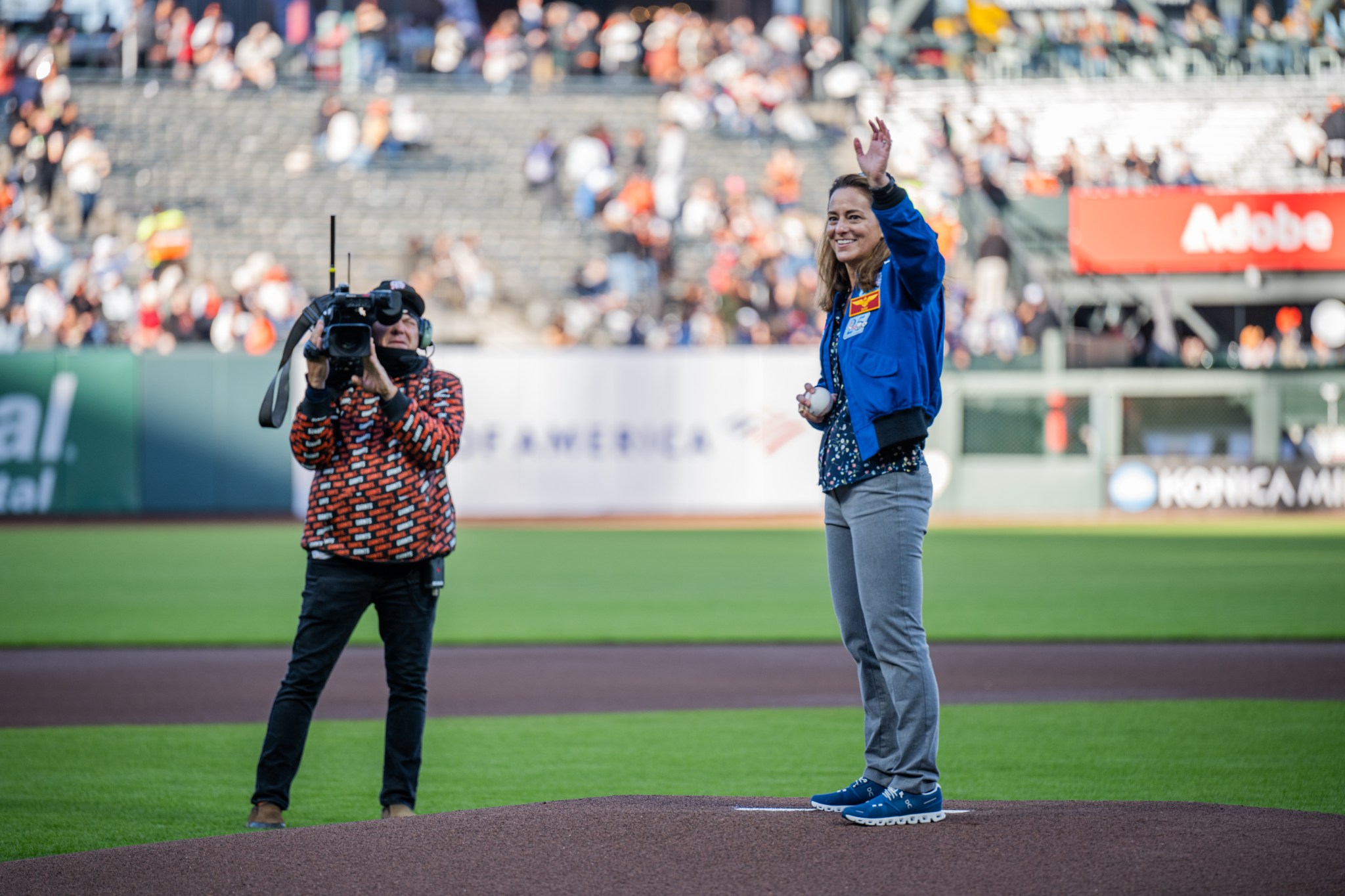
Faces of NASA: Human Factors Researcher Garrett Sadler
“I graduated in 2008, so that job market was not super great, and I ended up with this very unusual job working for this guy who thought that he had some new theory of physics that he wanted to work on. And so I was responsible for creating little computer simulations, trying to resemble some version of his ideas. His whole thing was like a quasi-spiritual tool, looking toward science as a rationalization of different spiritual beliefs that he had about a collective consciousness and the interconnectedness of things.
“As I worked for him longer and met a bunch of other people who were trying to put various spiritual beliefs on scientific footing, I got interested [and thought] maybe this could be studied as a cultural thing. What’s going on here with the desire to scientifically explain spiritual beliefs that they have? What’s the dynamic going on there? That’s what led me into eventually going to grad school for anthropology. I studied the way that science gets conceptualized and interpreted to rationalize spiritual and religious beliefs.
“I had this sort of unconventional trajectory [to NASA]. I didn’t really set a target on something to pursue it. The other thing that might be surprising is that I’ve been insecure about it at every single stage. You know, there’s the whole impostor syndrome thing, and I didn’t feel like I was qualified to be here because I didn’t have some sort of traditional path or because my educational background looks different than that of most of my colleagues. But I’m now at a place where I’ve come to understand that’s true for everyone.”
– Garrett Sadler, Human Factors Researcher, NASA’s Ames Research Center
Click here for other Faces of NASA
Ames Veterans Community Outreach Team Receives Federal Employee of the Year Award
by Maria C. Lopez
As part of the Ames Veterans Committee (AVC) employee resource group, Brad Ensign, and James Schwab, who are both Army veterans, work to support other veterans and our local Afghan and Ukrainian war refugee communities. The fall of Afghanistan to the Taliban was especially heart wrenching for Afghan war veterans and created a feeling of discouragement. The war in Ukraine only increased the level of disheartenment for many veterans. Importantly, the Ames Veterans Committee provides a forum to help veterans heal, and just as importantly, help our local community deal with the influx of Afghan and Ukrainian war refugees.
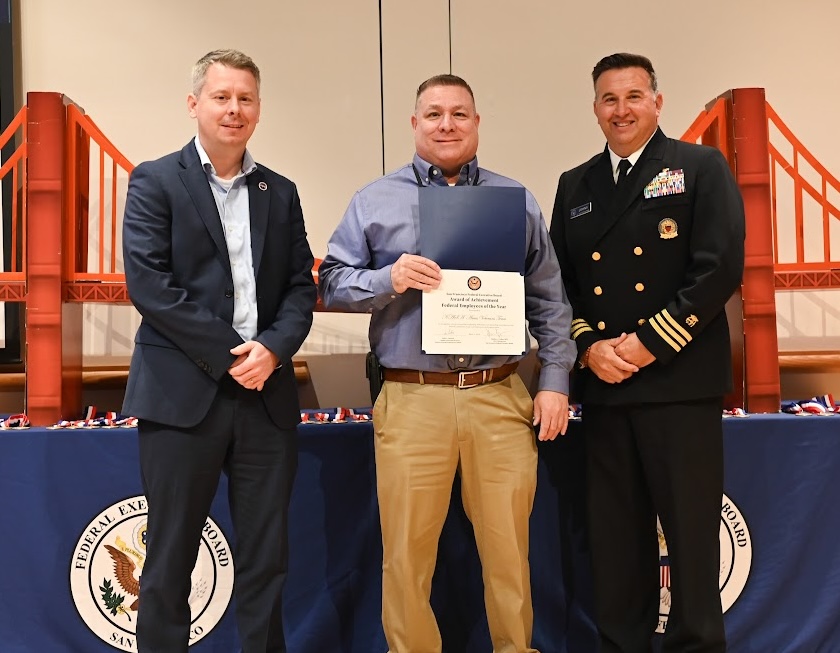
Through the AVC Community Outreach Team, Brad Ensign coordinated to donate computers from the Ledios company, which is NASA’s Workplace & Collaboration Services to The Jewish Family & Community Services – East Bay and The Jewish Family Services of Silicon Valley. Leidos was awarded the Advanced Enterprise Global Information Technology Solutions (AEGIS) contract by NASA. In addition to AEGIS, Leidos provides enterprise IT services to NASA through the NASA End-User Services and Technologies (NEST) contract. Both contracts support NASA’s overall IT operation and mission. Once an end-user computer reaches the device’s end-of-life cycle per the NEST contract, the computers are repurposed for local charity use. The computers are verified to be in good working condition by the Leidos/NEST team.
Brad Ensign periodically pings the Ames NEST Center Operations manager for available computer donations and the manager verifies that good working computers are available for donation. Brad then contacts various Afghan and Ukrainian war refugee assistance charities to determine their computer needs. Many of these local charities rely on donations and do not have an IT budget. Once a need is determined by local charities, Brad coordinates the number of computers available and a delivery date and time. James Schwab enthusiastically supports this effort and has provided incredible logistical support transporting the computers to the donation location.
Notably in October 2023, Brad and James successfully delivered 25 laptop computers, five desktop computers, and 30 monitors to the Jewish Family & Community Services – East Bay.
The support for the Jewish Family & Community Services continued and in December of 2023, Brad helped deliver groceries to Afghan war refugees. So far this year, Brad, James, the Ledios company, and the NASA Ames Veterans Committee have donated a total of 40 computers and 40 monitors. These computers are extremely helpful for Afghan and Ukrainian war refugees to write resumes, find jobs, communicate with loved ones left behind, assist with personal tasks, stay informed of world and local news, help their children with schoolwork, and for entertainment. Donated computers are a tremendous resource for local war refugees and this initiative helps NASA Ames Veterans ease feelings of distress by making a difference in their community.
On May 9, 2024, Brad and James received a Federal Employee of the Year Award from the San Francisco Federal Executive Board (SFFEB) for Volunteer Excellence based on their leadership on creating opportunities for the Ames Veterans Committee to work together during a trying time for veterans while making an ongoing, positive impact in the local community.
Hangar 3 Historical Website is Now Live!
The Historic Preservation Office at NASA Ames’ Hangar 3 historical web site is now live! Ames Research Center and Planetary Ventures, in consultation with the National Park Service, California State Historic Preservation Office, and the Advisory Council on Historic Preservation created a website and film that documents the history and features of Hangar 3, provides valuable information for future researchers, and celebrates its local and global impact.
You also can find additional historical information at NASA Ames and Moffett Field here, including buildings and districts listed in the National Register of Historic Places, information about Hangar 1 and Hangar 3, historical resources associated with the Space Shuttle and NASA Ames, and much more!
LEGO Fans Compete in Rocket and Rover Building Contests, Learn about VIPER
On May 31, in collaboration with LEGOLand Bay Area, in Milpitas, California. NASA Ames participated in an exploration-themed evening for adult LEGO enthusiasts. More than 90 guests participated in scavenger hunts and NASA astronaut photo opportunities. LEGO speed-building contests were held to build rockets and rovers while wearing thick gloves simulating the challenges astronauts experience during an extravehicular activity or spacewalk. Building on the exploration theme, guests built rovers that were judged on creativity and build quality. Three prizes were awarded for people’s choice, judges’ choice, and adherence to NASA engineering principals. The main feature of the evening was the presentation and question-and-answer session with Ames’ Lorretta Falcone, mission planner for the VIPER mission, NASA’s first robotic lunar rover.
2024 Open Sauce Conference Creators Visit and Tour NASA Ames
On Monday, June 17, creators and makers of the 2024 Open Sauce Conference in San Francisco visited NASA’s Ames Research Center for a behind-the-scenes tour of our world-class research facility. Participants arrived at Ames and received a summary of the day’s activities as well as an overview of Ames from center leadership. They heard a lightning talk about NASA’s Advanced Composite Solar Sail System mission and then toured several facilities on center and meeting with experts at each facility. Facilities include the Vertical Motion Simulator (VMS), Unitary Plan Wind Tunnel, Arc Jet Complex, and Roverscape. Tour attendees included top creators in aerospace, science, and engineering, and have a combined reach of tens of millions of highly engaged audiences around the world.
In Memoriam …
Fred Martwick, Senior Engineer at Ames, Passes Away
It is with great sadness we share with you the news that our good friend and colleague, Fred G. Martwick, passed away on April 29, 2024, after a brief illness. A Celebration of Life service was held on June 11, at the Calvary Church in Los Gatos. In addition, a flag ceremony was held to honor Fred on June 25 in front of the N-200 flagpole at NASA Ames.
Graduating in 1985 with a BS in mechanical engineering from San Jose State, Fred began his career with IBM in south San Jose. After a few years, he came on-board at NASA Ames as a support service contractor in the Engineering Division. His abilities and personal work ethic were recognized, and he was quickly recruited for civil service (CS) conversion, first becoming an Army CS employee in the early 1990s, and later transitioning to NASA CS.
In the 1990s, Fred supported and then led several successful space sciences projects. Concurrently, he served as one of the Ames representatives of the Aerospace Mechanisms Symposium organizing committee, consisting of representatives from the other NASA centers and Lockheed Martin. This group organized and sponsored the symposium on a set rotation within the NASA centers.
In the late 1990s, after an offsite contractor failed to meet NASA’s specifications and timeline, the successful partnership of Fred and Dave Ackard managed the onsite manufacture and assembly of the SOFIA Cavity Door. In the 2000s, Fred managed the planning, design, and prototype fabrication of a nano-satellite and deployment system in conjunction with Stanford. Fred then managed the challenging procurement and fabrication of an intricate powered wind tunnel model of the Orion Crew Escape System. The model and subsequent tests were key elements for the analysis test verification of the Escape System.
In the 2010s, Fred had established an intricate manufacturing documentation control system, creating a contracting “war room” in the mezzanine above the N211 Fabrication Shop. From here, large amounts of space flight certified animal hardware were planned, contracted, tracked, assembled, and certified for flight to the International Space Station. Fred’s procurement and documentation control system greatly impressed visiting customers from NASA/JSC management. In 2014, Fred was awarded the coveted Silver Snoopy Award in recognition of his outstanding performance in space flight system development and manufacturing.
By the 2020s, Fred had moved to the Chief Engineers Office in Code D supporting project oversight while keeping an eye on his upcoming retirement. Fred’s dedication to NASA had pushed his retirement out a few times but was well within sight with the purchase of a beautiful home near Spokane, Washington. He was very involved with the organization Assist International and enjoyed working with the project Caminul Felix in Romania. Additionally, he worked with the Calvary Church ministry with junior high school kids. He was bus driver for the kids at the ministry, taking them to Hume Lake Christian Camp where he was the waterskiing boat driver for the kids as they waterskied behind the boat around the lake.
Fred will be greatly missed by the many people who have worked with him over his 30 plus years of outstanding service. He will be remembered as a man of unwavering faith, a shrewd negotiator, an excellent project manager and systems engineer capable of diving into and clearly documenting the details while not losing sight of the big picture. His ability to “get things done” makes his passing a great loss for NASA.






























